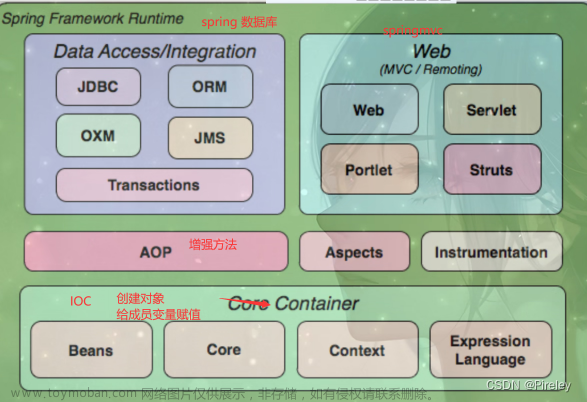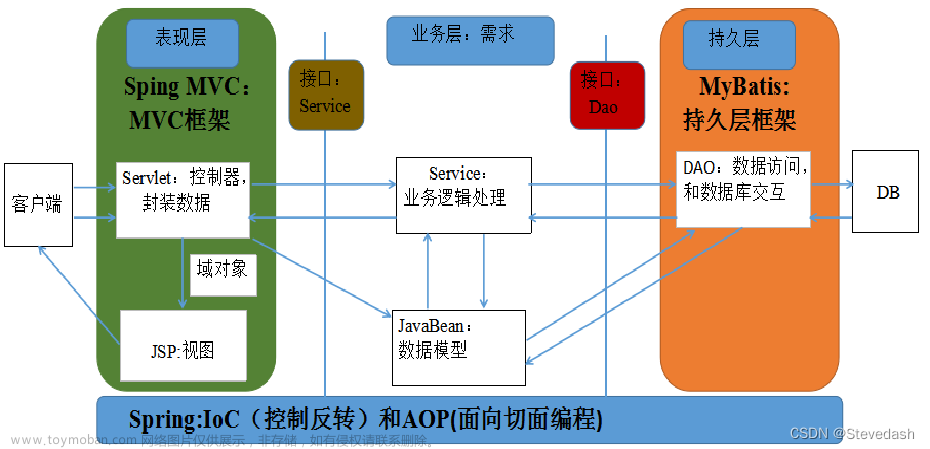
🎬 艳艳耶✌️:个人主页
🔥 个人专栏 :《Spring与Mybatis集成整合》
⛺️ 生活的理想,为了不断更新自己 !

1.前言
1.1.什么是注解
Annontation是Java5开始引入的新特征,中文名称叫注解。
它提供了一种安全的类似注释的机制,用来将任何的信息或元数据(metadata)与程序元素(类、方法、成员变量等)进行关联。为程序的元素(类、方法、成员变量)加上更直观、更明了的说明,这些说明信息是与程序的业务逻辑无关,并且供指定的工具或框架使用。Annontation像一种修饰符一样,应用于包、类型、构造方法、方法、成员变量、参数及本地变量的声明语句中。
Java注解是附加在代码中的一些元信息,用于一些工具在编译、运行时进行解析和使用,起到说明、配置的功能。注解不会也不能影响代码的实际逻辑,仅仅起到辅助性的作用。
1.2.注解的用处
- 生成文档。这是最常见的,也是java 最早提供的注解。常用的有@param @return 等
- 跟踪代码依赖性,实现替代配置文件功能。比如Dagger 2 依赖注入,未来java 开发,将大量注解配置,具有很大用处;
- 在编译时进行格式检查。如@override 放在方法前,如果你这个方法并不是覆盖了超类方法,则编译时就能检查出。
1.3.注解的原理
注解本质是一个继承了Annotation 的特殊接口,其具体实现类是Java 运行时生成的动态代理类。而我们通过反射获取注解时,返回的是Java 运行时生成的动态代理对象$Proxy1。通过代理对象调用自定义注解(接口)的方法,会最终调用AnnotationInvocationHandler 的invoke 方法。该方法会从memberValues 这个Map 中索引出对应的值。而memberValues 的来源是Java 常量池。
2.注解的案列:
2.1 案例一(获取类与方法上的注解值)
定义一个类:
package com.sy.annotation.pi;
public enum TranscationModel {
Read, Write, ReadWrite //定义三个实例,可以将它看作类
}写三个注解:
package com.sy.annotation;
import java.lang.annotation.*;
/**
* MyAnnotation1注解可以用在类、接口、属性、方法上
* 注解运行期也保留
* 不可继承
*/
@Target({ElementType.TYPE, ElementType.FIELD,ElementType.METHOD})
@Retention(RetentionPolicy.RUNTIME)
@Documented
public @interface MyAnnotation1 {
String name();
}package com.sy.annotation;
import java.lang.annotation.*;
/**
* MyAnnotation2注解可以用在方法上
* 注解运行期也保留
* 不可继承
*/
@Target(ElementType.METHOD)
@Retention(RetentionPolicy.RUNTIME)
@Documented
public @interface MyAnnotation2 {
TranscationModel model() default TranscationModel.ReadWrite;
}
package com.sy.annotation;
import java.lang.annotation.*;
/**
* @author shenyan
*
* MyAnnotation3注解可以用在方法上
* 注解运行期也保留
* 可继承
*/
@Target(ElementType.METHOD)
@Retention(RetentionPolicy.RUNTIME)
@Inherited
@Documented
public @interface MyAnnotation3 {
TranscationModel[] models() default TranscationModel.ReadWrite;
}
创建几个方法使用这些注解
package com.sy.annotation.Demo1;
import com.sy.annotation.MyAnnotation1;
import com.sy.annotation.MyAnnotation2;
import com.sy.annotation.MyAnnotation3;
import com.sy.annotation.TranscationModel;
/**
* @author shenyan
*
* 获取类与方法上的注解值
*/
@MyAnnotation1(name = "艳艳耶")
public class Demo1 {
@MyAnnotation1(name = "csdn")
private Integer age;
@MyAnnotation2(model = TranscationModel.Read)
public void list() {
System.out.println("list");
}
@MyAnnotation3(models = {TranscationModel.Read, TranscationModel.Write})
public void edit() {
System.out.println("edit");
}
}
最后,进行测试



2.2 案例二(获取类属性上的注解属性值,默认值的赋予)
自定义一个注解,并赋予默认值:
package com.sy.annotation.Demo2;
import java.lang.annotation.ElementType;
import java.lang.annotation.Retention;
import java.lang.annotation.RetentionPolicy;
import java.lang.annotation.Target;
/**
* @author shenyan
* /
//@Retention(RetentionPolicy.SOURCE)
@Retention(RetentionPolicy.RUNTIME)
@Target(ElementType.FIELD)
public @interface TestAnnotation {
String value() default "默认value值";
String what() default "这里是默认的what属性对应的值";
}
建立类测试:
有些两个值都赋予了,有些只赋予了一个
package com.sy.annotation.Demo2;
/**
* @author shenyan
*
* 获取类属性上的注解属性值
*/
public class Demo2 {
@TestAnnotation(value = "这就是value对应的值_msg1", what = "这就是what对应的值_msg1")
private static String msg1;
@TestAnnotation("这就是value对应的值1")
private static String msg2;
@TestAnnotation(value = "这就是value对应的值2")
private static String msg3;
@TestAnnotation(what = "这就是what对应的值")
private static String msg4;
}
测试结果:


2.3 案例三(获取参数修饰注解对应的属性值,非空注解)
同样,先建立一个非空注解
package com.sy.annotation;
import java.lang.annotation.*;
/**
* @author shenyan
*
* 非空注解:使用在方法的参数上,false表示此参数可以为空,true不能为空
*/
@Documented
@Target({ElementType.PARAMETER})
@Retention(RetentionPolicy.RUNTIME)
public @interface IsNotNull {
boolean value() default false;
}
建立方法,进行测试:
package com.sy.annotation.Demo3;
import com.sy.annotation.IsNotNull;
/**
* @author shenyan
*
* 获取参数修饰注解对应的属性值
*/
public class Demo3 {
public void hello1(@IsNotNull(true) String name) {
System.out.println("hello:" + name);
}
public void hello2(@IsNotNull String name) {
System.out.println("hello:" + name);
}
}测试类:
方法1:

方法2:

方法3:

3.AOP结合自定义注解案例
配置相关AOP pom文件
<dependency>
<groupId>org.springframework.boot</groupId>
<artifactId>spring-boot-starter-aop</artifactId>
</dependency>
applicationContext.xml
<?xml version="1.0" encoding="UTF-8"?>
<beans xmlns="http://www.springframework.org/schema/beans"
xmlns:xsi="http://www.w3.org/2001/XMLSchema-instance"
xmlns:context="http://www.springframework.org/schema/context" xmlns:tx="http://www.springframework.org/schema/tx"
xmlns:aop="http://www.springframework.org/schema/aop"
xsi:schemaLocation="http://www.springframework.org/schema/beans http://www.springframework.org/schema/beans/spring-beans.xsd http://www.springframework.org/schema/context http://www.springframework.org/schema/context/spring-context.xsd http://www.springframework.org/schema/tx http://www.springframework.org/schema/tx/spring-tx.xsd http://www.springframework.org/schema/aop http://www.springframework.org/schema/aop/spring-aop.xsd">
<!--1. 注解式开发 -->
<!-- 注解驱动 -->
<context:annotation-config/>
<!-- 用注解方式注入bean,并指定查找范围:com.javaxl.ssh2及子子孙孙包-->
<context:component-scan base-package="com.zking"/>
<!--开启动态代理-->
<aop:aspectj-autoproxy />
</beans>定义一个标志日志的注解
package com.sy.annotation;
import java.lang.annotation.ElementType;
import java.lang.annotation.Retention;
import java.lang.annotation.RetentionPolicy;
import java.lang.annotation.Target;
/**
* @author shenyan
*/
@Target(ElementType.METHOD)
@Retention(RetentionPolicy.RUNTIME)
public @interface MyLog {
String desc();
}再创建一个切面类 LogAspect,用于实现日志记录的逻辑。
package com.sy.annotation.aop;
import com.sy.annotation.MyLog;
import org.aspectj.lang.JoinPoint;
import org.aspectj.lang.annotation.Aspect;
import org.aspectj.lang.annotation.Before;
import org.aspectj.lang.annotation.Pointcut;
import org.aspectj.lang.reflect.MethodSignature;
import org.slf4j.Logger;
import org.slf4j.LoggerFactory;
import org.springframework.stereotype.Component;
/**
* @author shenyan
*/
@Component
@Aspect
public class MyLogAspect {
private static final Logger logger = LoggerFactory.getLogger(MyLogAspect.class);
/**
* 只要用到了com.javaxl.p2.annotation.springAop.MyLog这个注解的,就是目标类
*/
@Pointcut("@annotation(com.sy.annotation.MyLog)")
private void MyValid() {
}
@Before("MyValid()")
public void before(JoinPoint joinPoint) {
MethodSignature signature = (MethodSignature) joinPoint.getSignature();
logger.debug("[" + signature.getName() + " : start.....]");
System.out.println("[" + signature.getName() + " : start.....]");
MyLog myLog = signature.getMethod().getAnnotation(MyLog.class);
logger.debug("【目标对象方法被调用时候产生的日志,记录到日志表中】:"+myLog.desc());
System.out.println("【目标对象方法被调用时候产生的日志,记录到日志表中】:" + myLog.desc());
}
}在方法上运用日志注解
package com.sy.annotation.aop;
import com.sy.annotation.MyLog;
import org.springframework.stereotype.Controller;
import org.springframework.web.bind.annotation.RequestMapping;
/**
* @author shenyan
*/
@Controller
public class LogController {
@RequestMapping("/myLog")
@MyLog(desc = "这是结合spring aop知识,讲解自定义注解应用的一个案例")
public void testLogAspect(){
System.out.println("这里随便来点啥");
}
}
运行结果:

今日分享结束!文章来源:https://www.toymoban.com/news/detail-732235.html
 文章来源地址https://www.toymoban.com/news/detail-732235.html
文章来源地址https://www.toymoban.com/news/detail-732235.html
到了这里,关于【springMvc】自定义注解的使用方式的文章就介绍完了。如果您还想了解更多内容,请在右上角搜索TOY模板网以前的文章或继续浏览下面的相关文章,希望大家以后多多支持TOY模板网!












